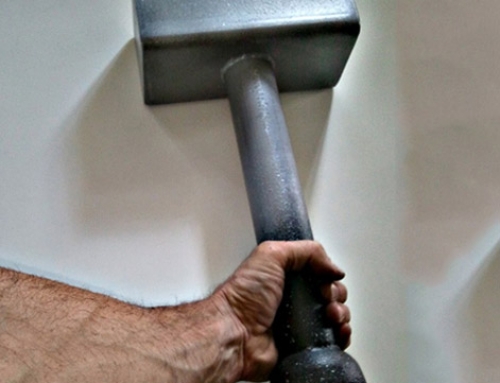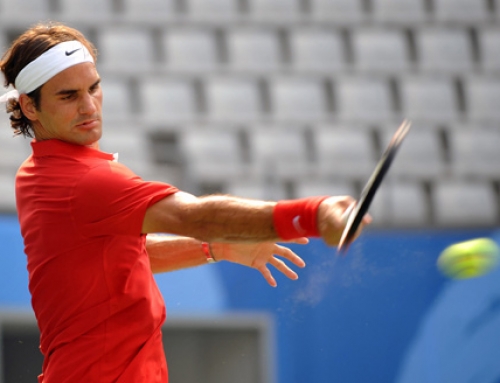This week’s show is early and a little bit on the short side due to some holiday travels, but there’s still a new show! Listen in as I discuss the pros and cons of the full western grip. Why exactly is it dubbed “extreme” by myself and many other teachers of tennis? Is it the wrong grip for the recreational level player?
Download Transcript: Word Doc | PDF | Kindle | Text
Welcome to the Essential Tennis Podcast.
If you love tennis and want to improve your game, this podcast is for you. Whether it’s technique, strategy, equipment, or the mental game, tennis professional Ian Westermann is here to make you a better player.
And now, here’s Ian!
Ian Westermann: Hi and welcome to the Essential Tennis Podcast. Your place for free expert tennis instruction that can truly help you improve your game.
Today’s episode of the Essential Tennis Podcast is brought to you by SomersetSportsPerformance.com.
Thank you very much for joining me today, and episode #93 of the Essential Tennis Podcast is going to be a special holiday edition. The two6th of November is Thanksgiving here in America. I’m out of town this week–and when I say this week, I’m releasing this Podcast on Friday November 20th, and then my wife and I are going out of town. We’re going to be away from home all next week, which is the week of Thanksgiving. So my time is very limited.
I’m away from my studio if you want to call at that next week. So I’m releasing this Podcast early and there’s going to be a little bit shorter version, because I just don’t have a lot of time during the week to record the show. So please excuse me for that, but I know a lot of my American listeners are very busy as well.
But I still wanted to get a show out. So it’s going to be a little bit shorter shout today. I just have a little bit of a message for you guys on the other side of this quick break. A nd I’m going to be answering a listener question as well about different grips and the full Western forehand grip specifically. So sit back, relax and get ready for some great tennis instructions.
Alright, let’s get started with today’s show. And in doing so, I would like to send the message out to all of you listening to the Essential Tennis Podcast. And whether you’ve been with me from the beginning of the show when I first started about year and a half ago, or maybe you’ve just been listening for a couple of weeks–or maybe this is even your first show, and I don’t do this every show if this is your first show. But just in the spirit of–and I was thinking on my drive home from work today that I really am thankful for this show and for my audience. I want to tell that to you guys. And again the reason why I’m not doing the full length show today for Podcast #93 is that I’m out of town for Thanksgiving. And Thanksgiving in the United States is a time for us here to stop and reflect and take a break and think about and remember all the blessings that we have, and all the reasons that we have to be thankful even in up and down times. Even in bad times when everything is not quite going your way whether in your own household, or maybe in your country, or maybe even in the world as a whole, there’s still so many things that we can be thankful for. And it is important to stop and reflect and think about that, I think. As people to be thankful. And that what’s Thanksgiving is all about. So about giving thanks for what we have.
And so I just wanted to give you guys a quick shout out all of you, all of my listeners. I’m so thankful for the opportunity to communicate and to teach all of you who listen about the sport of tennis, which I myself love and all of you love as well. Otherwise, you would not be listening. You wouldn’t be taking the time to actually download the show and listen to it. So I want to thank you guys for the opportunity that you’ve given me to speak to you. And you’ve given me that chance by giving me part of your time, and giving me your attention, and many of you are even giving me the opportunity to change your games. And you’re listening to the instruction that I’m giving you and going out and improving and writing me back and telling me about it and that’s such a rewarding thing for me. I never want to take that for granted and think that it’s all about me here, because it’s not–it’s all about you guys, the listeners. You guys are the ones that are improving your tennis and I’m just really happy, and thankful to be part of that.
So in the spirit of Thanksgiving I’ll wrap this little dialogue up. I just want to thank you guys and all of you who are listening right now. I really appreciate it. And all of you who are in the United States I hope that you all have a blessed Thanksgiving holiday.
Alright, now that that’s finished, let’s go ahead and start talking about some tennis. And I’m looking forward to talking about this topic and we’re just going to be one topic today, but I think it’s a very important thing for all of you to understand. And this topic has to do with the grips. It’s important to understand what’s certain grips are good for when it comes to ground strokes the frozen cons. And we’ve discussed this in the past probably briefly–and probably with some detail–but as with everything as I continue to teach I get better and better describing and explaining some things, and I think this is one of those areas.
So let’s read the question and this is comes to us from Roger in California. Roger wrote to me and said, ‘I have recently started using a full Western forehand grip to hit my forehands, and sometimes the grip between a semi and full Western. My coach told me that it’s a bad grip to use and not use it. I asked him why, but all he said was, ‘Because it’s bad. ‘ I did all the research and have found out that it’s hard hit low balls with that grip. Is there anything else with the full Western grip that could be possibly be bad as a coach yourself if I’m able to use the full Western forehand grip without a problem, would you recommend that I stick with it or should I try to avoid using that grip?’
That’s a very good question Roger. And I’m going to explain here the frozen cons of the Western grip and exactly why. And you don’t say here how old you are or what kind of coach you are talking, but I’m going go ahead and assume that you’re talking about a school coach, probably high school. Maybe college, but I’m going to go ahead and guess you’re a high school student. A nd a lot of high school tennis coaches are not terribly qualified. And that’s not to put down or knock high school coaches, because we certainly need them. T hey don’t volunteer their time usually. They do get paid, but it’s not very much, and it’s usually just set enjoyment for the game and usually they are player of themselves, but they are not really a qualified teacher. So it’s too bad that you’re coach wasn’t able to tell you why, and it was a good thing for you to ask why. And those of you who are listening you should aks why. You need to understand why certain things are and are not. And your coach is on the right track here Roger with what he’s telling you, but I’d be happy to explain to you exactly why.
So, first of all the full Western grip is a very extreme grip. And I mean extreme it’s a very far over grip. Ad let’s talk about why exactly.
First of all, the actual bio-mechanical reason why it’s extreme is this. Back in the old days everybody used a Continental grip. And a Continental grip is very easy to use to put them all back and play, because it puts your palm right flush and parallel with the racket face. With the strengths of the racket. When you hold the good Continental grip and you open up your hand, your palm becomes parallel to the racket face. So it’s very easy to direct the ball and tell it where to go.
Now a full Western grip puts your palm completely 90 degrees around the grip on the bottom of the grip, and if you go to a full Western grip and open up your hand without moving the racket, you’ll see that your palm is now perpendicular to the racket face. Your palm is facing up towards the sky when the racket face is facing forwards, OK?
So there’s a description of exactly how these grips change. How your hand is facing. How your palm is actually facing in relationship to the racket face. And this is very important. And the reason for that is there’s two main ways. There’s two main forces that we can put on the tennis ball for ground strokes. And one of those is drive. And drive simply means hitting the ball forwards towards your target. Drive in it’ purist form means hitting the ball without much spin. Without spin. Just driving the ball forwards towards your target. If you want to drive the ball very well and all you want to do is drive the ball without being able to hit top spin, then the Continental grip is for you.
Now top spin is created by swinging upwards as opposed to forwards. When you swing straight up, you make the most top spin possible. Now if you’re only concern with making top spin then the full Western grip is for you, because it faces your palm facing up. And so it allows you to swing upwards very aggressively and very steeply.
If all you are concerned with is driving the ball and just hitting the ball forwards, then the Continental grip is for you, because it puts your palm parallel to the racket face and so you can push your racket and swing your racket forwards through the ball towards your target and drive it flat.
So these are kind of the two extremes over on the forehand side and there’s all kinds of grips in between the Continental grip and the full Western grip. The two main ones being an Eastern forehand grip and a semi Western grip. Those are both in between the extremes of Continental–which is for driving–and full Western which is just purely for top spin, because your palm is facing straight up.
So hopefully that makes sense to you Roger. First of all, we need to have a good understanding of why and how these grips are good for what exactly before we really understand whether or not this grip is for you. So those are the reasons why Continental is good for hitting flat, and full Western is good for hitting top spin.
Now I personally prefer something in between those two so that I can have the ability to both drive the ball and hit with top spin. And everybody I teach I want them to be well rounded and to be able to hit whatever shot is necessary to perform well and to win points. And in my opinion, having a Continental grip is very limiting, because it’s going to really set you up to hit flat, but it’s going to be very difficult to hit with top spin.
Now is top spin impossible with the Continental grip? No, it’s not. It’s possible to hit top spin with the Continental grip. Just not to the same degree in the same extreme is with a Western forehand grip.
Now if you have a full Western grip just that mean it’s impossible to drive the ball and hit it forwards strongly? No, it’s not impossible, but just like Continental grip use a difficult to hit with top spin. A full Western leaves it difficult to drive the ball and hit it forwards.
So by nature these two extreme grips are going to make certain shots difficult. And that’s just the reality of how you positioning your body with the racket. You’re positioning your hand in different ways and different angles relative to the racket and so that leaves you with certain choices–or certain types of swings– being most conducive and being easiest to do.
So hopefully you’re following me Roger and everybody else listening.
So is this grip right for you? Well, I haven’t seen you play before, so I can’t tell you for sure. I haven’t seen you swing at the ball. But two questions that I would like you to answer for yourself in deciding whether or not you should use this grip. And the rest of you listening obvious these applies to you as well.
First of all, are you able to drive the ball and create pace on your own? And a good example of this is Roger when you receive a short shot–a weak ball–on your side of the court are you able to put it away? A symptom of somebody who has the grip turned over too far very often is that they’ll received a short weak shot on their own side of the court, and they have a lot of trouble putting the ball away or finishing points, because the faster and faster they swing, the more and more top spin they make–and the ball just ends up spinning faster and faster and faster, but it doesn’t really go through to the air any quicker. And so the ball rotates more and spins faster, but somebody with the very extreme grip very often times has a lot of trouble driving the ball and hitting the ball with speed and with pace.
And that’s where driving the ball all about it’s been able to hit pace on the ball and be able to pressure your opponent not just by curving it and spinning and looping it, but by hitting through it and pressuring them with pace.
So are you able to drive the ball and create pace? You need to ask yourself that and answer it honestly. And the rest of you guys who use the full Western grip I’d like you to ask yourself that and answer it honestly.
Secondly, the second question is: ‘Are you able to hit shots in a variety of different locations? Are you able to hit high shots comfortably? Are you able to hit shots at your waist comfortably? Are you able to hit low shots comfortably without switching your grip? Using that full Western grip?/ and you’re correct in doing your research that a symptom again of having a full Western grip is that low shots are typically uncomfortable and difficult to hit.
A symptom of somebody who hits with the Continental grip is that typically they have a hard time with higher shots, because the racket face is not very closed, and so it’s difficult for them to hit the ball confidently without it going too far when the ball is high in their strike zone.
I would like for you to have a grip that makes it easy to hit in a variety of places relative to your body. You should be trying to hit the ball in the same place over and over again, but it’s not always going to happen. So it’s important to be able to hit high shots, low shots, and shots in the middle comfortably.
So ask your self those two questions Roger. And if you can answer ‘yes’ to both of them. If you’re able to create pace and if you’re able to hit both high, low and middle shots as far as height is concerned comfortably, then I would say go ahead and stick with it. If you’re able to hit these varieties of shots and do it all with that same full Western grip–then by all means go ahead and stick with it. And I would recommend switching if you’re able to do versatile and do all of these things already.
Now if you answered ‘no’ to one of those two questions or both of them. I would highly suggest that you will get switching your grip to something a little bit more moderate. Just a semi Western would make it much easier to drive the ball as compared to the full Western.
So Roger hopefully that answers your question. A really good question and definitely let me know if I can help you any further with that.
[music] [music] [music]That brings episode #93 of the Essential Tennis Podcast to a close. Thank you very much for joining me today. I appreciate it. And two quick things before we wrap up the show completely.
First of all, if you are in the Destin Florida area, let me know. Send me an e-mail. That’s where I’m going to be next week during the week of Thanksgiving and be cool to meet up with anybody who might be living in that area and maybe go out and have a drink and chat about tennis. So let me know. My e-mail address is ian@essentialtennis.com.
Secondly, two shout outs and they are going to Dan and Doug at Forest Crest Tennis Club in North Seattle, Washington. I sent several e-mails back and forth with Dan earlier today who’s a fan of the show and I appreciated hearing from you Dan and he asked me to give a shot out to his friend Doug who turned them on to the Podcast originally, and appreciates him telling him about the show.
So to both of you guys thanks very much for being listeners. And I’m working on doing a clinic in the Seattle area. So definitely stay tuned on the show and I’ll let you guys know more details as I find out. But big shout outs to Dan and Doug in Seattle.
Alright that does it for this week’s show. Thanks again everybody for joining me. Take care and good luck with your tennis.






